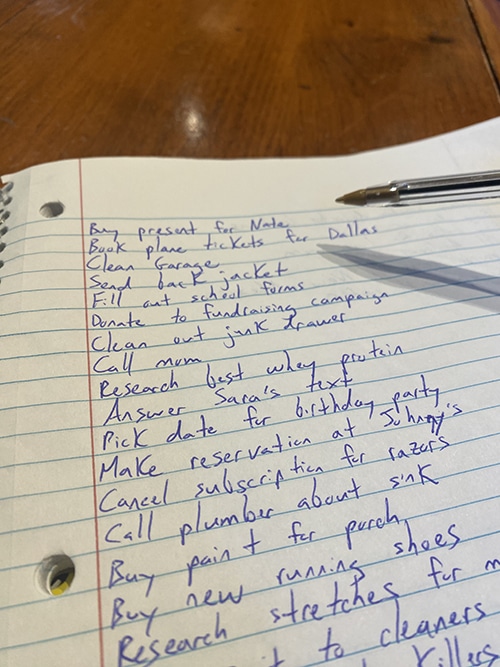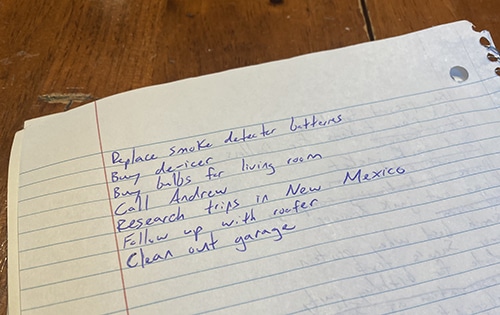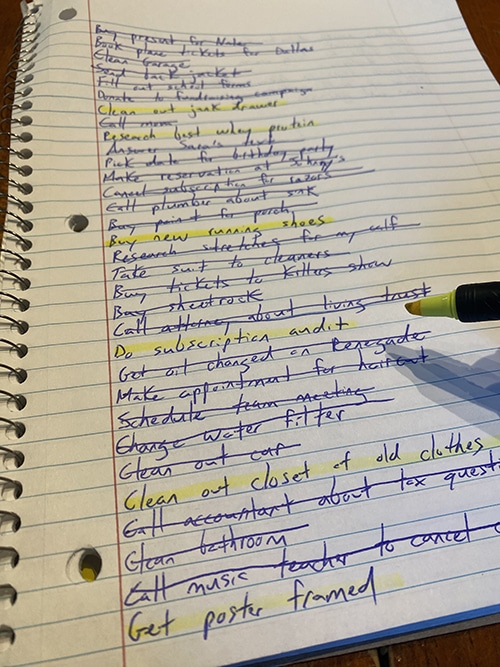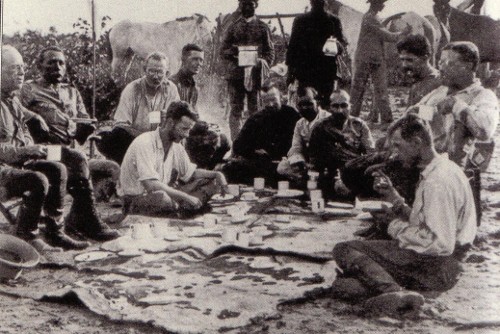
In one of the emails Oliver Burkeman, author of Time Management for Mortals, sent out to his subscribers, he talked about how we typically treat our to-do lists like buckets that we need to empty every day.
在奥利弗·伯克曼(《凡人时间管理》的作者)发送给订阅者的电子邮件中,他谈到了我们通常如何将待办事项列表视为需要每天清空的桶。
The problem, Burkeman observes, is that the to-do list is a bucket that never entirely empties. As we clear some tasks out, others are added in. It’s like the Magic Beer Floating Faucet Fountain that they used to sell at Spencer’s back in 1990, along with black lights and bags of reindeer poop.
问题是,伯克曼观察到,待办事项清单是一个永远不会完全清空的桶。当我们完成一些任务时,又会添加其他任务进来。就像1990年在Spencer's商店里卖的那种魔法啤酒浮动水龙头喷泉,还有黑灯和驯鹿粪便袋一起卖的那种。
Because you treat your to-do list like a bucket that needs emptying before it overflows, you get stressed out by the fact that it nonetheless remains perennially filled. Despite all the evidence to the contrary, you continue to carry the expectation that one day, if you work hard enough or find the right organizational system, you’ll finally get all caught up.
因为你把待办事项列表当作一个需要在溢出之前清空的桶,所以你对它始终保持填满感到压力。尽管有很多相反的证据,你仍然怀有期望,认为如果你足够努力或找到合适的组织系统,总有一天你会赶上所有事情。
There’s a better alternative to existing in this tense, unsatisfying state of productivity limbo where you constantly feel like you’re failing.
存在于这种紧张、不满意的生产力困境中,你会不断感觉自己失败,有更好的选择。
Burkeman argues that if you want to reduce the stress you feel about your to-do list, you need to change the analogy with which you frame it, from a bucket, to a river.
伯克曼认为,如果你想减少对待办事项清单的压力,你需要改变对待办事项的比喻方式,从一个桶变成一条河流。
When you go backpacking and stop at a river to fill up your hydration pack, you never think, “I need to capture ALL of this water that’s flowing by me.” That would be 1) impossible, and 2) silly.
当你背着背包旅行并停在河边给你的水袋装满水时,你从来不会想,“我需要捕捉流过我的所有水。”那既不可能,也很愚蠢。
Instead, you take what you need and then move on with your hike, not thinking twice about all the water you left behind.
相反,你只拿走你需要的东西,然后继续你的徒步旅行,对你留下的所有水不再多想。
You should treat life’s tasks and chores the very same way.
你应该以同样的方式对待生活中的任务和琐事。
The Autofocus Method & Its Benefits
自动对焦方法及其好处
Reading Burkeman’s analogy of thinking of your to-do list as a river reminded me of a productivity method I used years ago with great success that treated tackling life’s tasks from a similar perspective.
读到伯克曼将待办事项列表比作一条河的类比,让我想起了多年前我曾经非常成功地使用过的一种提高生产力的方法,它从类似的角度来处理生活任务。
Developed by writer and productivity expert Mark Forster, it’s called the Autofocus method.
由作家和效率专家马克·福斯特开发,它被称为“自动对焦法”。
Unlike most to-do list systems, Autofocus does away with categories, due dates, and priorities. You simply create one giant list of tasks (your river) and then work on whatever your focus is naturally drawn to when you review your list. This approach to productivity has several benefits:
与大多数待办事项列表系统不同,Autofocus不使用分类、截止日期和优先级。您只需创建一个巨大的任务列表(您的河流),然后在查看列表时自然地专注于您的关注点。这种提高生产力的方法有几个好处:
It treats your to-do list like the river it is. The Autofocus method accurately approaches your to-do list as a rushing stream that constantly carries in new things in need of doing. You can’t do all of them. The river will never be “done.” So instead of getting overwhelmed by this endless stream of to-dos, you simply dip your hand into the current and tackle the task you think is the right thing to do right now. Rather than worrying (too much) about the other stuff, you go with the flow.
它将你的待办事项清单视为一条河流。自动聚焦方法准确地将你的待办事项清单视为一条急流,不断带来需要完成的新事物。你无法完成所有的事情。这条河流永远不会“完成”。所以,与其被这无尽的待办事项清单压倒,你只需将手伸入水流中,处理你认为现在应该做的任务。与其过多地担心其他事情,你随波逐流。
It combines reason and emotion in your decision-making. Forster argues that the Autofocus method combines both the rational and intuitive parts of your mind. You do the right thing that you think and feel needs to be done at that time. The feeling part is important. If you don’t feel like doing something or have the ganas to do it, you likely won’t do it.
它在你的决策中结合了理性和情感。福斯特认为,自动对焦方法结合了你思维和直觉的两个部分。你会在那个时候做你认为和感觉需要做的正确的事情。感觉部分很重要。如果你不想做某件事或者没有动力去做,你可能不会去做。
If I look at lists I’ve entered into my Todoist, I’ve got several items that I’ve scheduled and prioritized because I rationally told myself that it makes logical sense to do these things on this schedule and at this priority.
如果我查看我输入到我的Todoist中的列表,我有几个项目已经安排和优先级排序,因为我理性地告诉自己,在这个时间表和优先级上做这些事情是有逻辑意义的。
But they’ve been on my Todoist for months showing “overdue.” No amount of reason can get me to do those things because there isn’t enough emotion or feeling to move me to do them.
但是它们已经在我的Todoist上显示为“过期”几个月了。无论多么理性的原因都无法让我去做这些事情,因为没有足够的情感或感觉来激励我去做。
You might be thinking, “But what about something like taxes? No one wants to do taxes, so if you just went by feeling alone in deciding to do your taxes, they’d never get done.”
你可能会想,“但是税收呢?没有人愿意做税收,所以如果你只凭感觉决定是否要做税收,那么税收永远不会完成。”
But in my experience, I haven’t found this to be true. My feelings get plenty stirred as I get closer and closer to the tax deadline. It’s not a positive emotion. It’s basically the fear of getting a penalty from the IRS, but I eventually feel plenty when it comes to my taxes.
但根据我的经验,我并没有发现这是真的。随着税务截止日期的临近,我的情绪会被激发得越来越多。这并不是一种积极的情绪。基本上是对从国税局处罚的恐惧,但当涉及到我的税务时,我最终会感到足够的情绪。
It’s the same thing with other jobs, though the motivation can arrive without any rhyme or reason. So it’s true that most days you probably don’t feel like cleaning out the garage. But there likely are times when the urge to do so randomly strikes, and when that urge arises, the Autofocus method will prompt you to ride it.
虽然动机可能毫无道理地出现,但其他工作也是一样的。所以,大多数时候你可能不想清理车库。但很可能会有时候突然想要清理,当这种冲动出现时,Autofocus方法会提示你去完成它。
It encourages little and often work. Autofocus promotes a “little and often” approach to large tasks. With this method, you work on something as long as you want, and if you’re not done with it, you cross it off where it was on the list and add it anew to the bottom of the list. You can work on that thing again when you feel it’s the right time.
它鼓励小而频繁的工作。自动对焦鼓励对大任务采取“少而经常”的方式。按照这种方法,你可以根据自己的意愿工作,如果还没完成,就把它从列表中划掉,并重新添加到列表底部。当你觉得合适的时候,可以再次开始处理这个事项。
Oftentimes, an all-or-nothing approach to doing chores results in doing nothing. With Autofocus, you do a bit at a time until the job is done.
往往,对家务事采取全力以赴的方式最终导致什么都没做。使用自动对焦,你可以一点点地完成任务,直到完成为止。
It re-acquaints you with self-trust. It may seem like a “system” as simple as this couldn’t possibly work. That’s because most productivity systems are based on the idea that you can’t trust yourself; their underlying premise is that you’re basically a lazy SOB who won’t get anything done without firm schedules and deadlines. But could it be that you think of yourself that way, and have largely acted in line with that assessment in the past, because you’ve only ever tried to tackle tasks based on external schedules and deadlines? Maybe you’re not a lazy SOB, maybe that’s just not an effective way to work, and you’d actually be more productive if you simply set out to get done whatever it is you feel like getting done each day. Maybe you’d discover you actually do have plenty of impulses to complete tasks once you start regularly prompting yourself to consider what you’re up for doing and let yourself choose what you’d like to work on.
它重新让你重新认识到自我信任。这个看起来像一个简单的“系统”似乎不可能起作用。这是因为大多数生产力系统都基于这样一个观点:你不能相信自己;它们的基本前提是你基本上是一个懒惰的家伙,如果没有严格的日程安排和截止日期,你什么都不会完成。但是,你是否认为自己是这样的人,并且在过去的大部分时间里都按照这种评估行事,是因为你只是根据外部的日程安排和截止日期来处理任务?也许你不是一个懒惰的家伙,也许那只是一种不有效的工作方式,如果你只是设定每天要完成的任务,你实际上会更有生产力。也许你会发现,一旦你开始定期促使自己考虑你想做什么,并让自己选择你想要工作的内容,你实际上有很多完成任务的冲动。
Try trusting yourself that if a task is important, you’ll eventually want to do it. And that if you never want to do it, it may not actually be important.
试着相信自己,如果一项任务很重要,你最终会想去做。而如果你从未想过去做它,那么它可能并不重要。
The paradox around productivity is that the less pressure you feel about how and what you “ought” to be getting done, the more you can actually get done.
生产力的悖论在于,你对自己应该如何以及应该完成什么任务的压力越小,你实际上能完成的工作就越多。
How to Use the Autofocus Method
如何使用自动对焦方法
Forster has modified his system over time, but I like the brilliantly simple version that I used back in the day. There isn’t much to it beyond what we’ve already mentioned: create one giant to-do list, look over the list, and do the task that jumps out to you.
福斯特随着时间的推移修改了他的系统,但我喜欢我过去使用的那个极其简单的版本。除了我们已经提到的内容外,它没有太多的东西:创建一个巨大的待办事项列表,查看列表,然后完成突出的任务。
But there are a few more bits of structure and strategy that help keep the system moving along; here are Forster’s instructions and more details about how to do it:
但是还有一些更多的结构和策略可以帮助系统保持运转;以下是福斯特的指示和更多关于如何做到这一点的细节:

Page 1 of a mega master to-do list.
一个超级主要待办事项清单的第一页。
1. Create one long list of everything you have to do or want to do in a notebook. One item per line.
在笔记本上创建一个长列表,列出你需要做或想做的所有事情。每行一个项目。
Don’t build a dam in your river of tasks by analyzing each item you put down to determine its priority and then filtering it into an appropriate task channel. That often takes too much work and usually replaces the work of actually getting the things you need to get done, done.
不要通过分析每个任务来建立任务河中的堤坝,以确定其优先级,然后将其过滤到适当的任务通道中。这通常需要太多的工作,而且通常会取代实际完成所需完成的工作。
You don’t even need to evaluate whether you should be writing down a task or not. Simply jot down whatever comes to mind, as it comes to mind. With the Autofocus process, items will naturally be culled later on.
你甚至不需要评估是否应该写下一个任务。只需随心所欲地记下任何想法。使用自动聚焦的方法,项目将在以后自然被筛选出来。
The first time you create your list, it might be multiple pages long. That’s okay! Remember, this is a river, not a bucket! You won’t be doing all of these things at once.
第一次创建列表时,可能会有多页。没关系!记住,这是一条河流,而不是一个桶!你不会一次做完所有这些事情。
2. Read quickly through all the items on the first page without taking action on any of them. You’re just getting a feel of the stream of tasks in front of you.
快速阅读第一页上的所有项目,不对任何项目采取行动。你只是在了解眼前任务的流程。

3. Go through the first page again, more slowly this time, looking at the items in order until one stands out for you. Forster says that this is the heart of the system. When you look at an item, you know it stands out when you feel like now is the time to do it. Forster says the feeling is hard to describe but easy to recognize.
3. 再次仔细阅读第一页,这次要更慢一些,按顺序查看每个项目,直到有一个项目引起你的注意。福斯特说这是系统的核心。当你看到一个项目时,你会感觉到现在是做它的时候。福斯特说这种感觉很难描述,但很容易辨认出来。
4. Work on that item for as long as you feel like doing so.
尽情地为那个项目工作。

If you begin work on a task, but don’t finish it, cross it off and move it to the bottom of the list (on the second page in this example).
如果你开始做一项任务,但没有完成,划掉它并将其移到列表底部(在这个例子中是第二页)。
5. Cross the item off the list; re-enter it at the end of the list if you haven’t finished it yet. This is the part of Autofocus that encourages “little and often.” For example, if you have a task to clean the garage, you put it on your list, do it when you feel like it’s the right time, clean for as long as you feel like doing so, and put it back at the bottom of the list if you haven’t finished. You can work on it again when the time is right.
将项目从清单上划掉;如果你还没有完成它,将其重新放在清单的末尾。这是Autofocus的一个鼓励“少而频繁”的部分。例如,如果你有一个清理车库的任务,你把它放在清单上,当你觉得是合适的时候开始做,清理的时间取决于你的心情,如果你没有完成,就把它放回清单的底部。当时机合适时,你可以再次开始工作。
6. Review the list on the first page again in the same way. Don’t move to the second page until you complete a pass of the first page without any item standing out.
再次以同样的方式查看第一页上的列表。在没有任何项目引起注意之前,不要转到第二页。

Review page 2 and see if a task jumps out to you.
请查看第2页,看看是否有一个任务引起了你的注意。
7. Move on to the next page and repeat the process. Whenever you have time, look at your list to see if there are items you feel prompted to complete. I think regularly looking at the list is a key to success with Autofocus: you don’t generally think about tasks that need doing by default; you have to keep prompting yourself to consider what things you can knock out.
继续翻到下一页并重复这个过程。每当你有时间,看看你的清单,看看是否有你感觉需要完成的项目。我认为定期查看清单是使用自动聚焦取得成功的关键:通常你不会主动考虑需要完成的任务;你必须不断提醒自己考虑哪些事情可以解决掉。
8. Once you’ve finished with the final page, re-start at the first page that is still active. Repeat the process.
一旦你完成了最后一页,请重新从仍然活动的第一页开始。重复这个过程。

9. If you get to a page and no item stands out for you on your slow pass through it, then all the outstanding items on that page are dismissed without re-entering them. (Unless it’s the last page where you’re still adding new items.)
如果你浏览一个页面时没有任何项目引起你的注意,那么该页面上所有突出的项目都会被忽略,不再重新输入它们。(除非这是最后一页,你仍然在添加新项目。)
Use a highlighter to mark dismissed items. This is how you cull items from your river of tasks. Just because you dismissed an item, doesn’t mean it has to be dismissed permanently. Maybe right now it’s not the thing you need to focus on, but in a few months or next year, it might be.
使用荧光笔标记已解决的事项。这是你从任务河中筛选事项的方法。只是因为你解决了一个事项,并不意味着它必须永久解决。也许现在它不是你需要关注的事情,但在几个月或明年,它可能会成为重点。
Feel free to revisit dismissed items every now and then to see if you feel like they need to be put back on your active list.
随时随地重新审视被忽略的事项,看看是否觉得它们需要重新放回你的活动列表中。

All items on page 1 have either been worked on or dismissed; page 1 has become an inactive page.
第一页上的所有项目都已经处理或被忽略;第一页已经变成了一个不活跃的页面。
10. When all the items on a page in your notebook are crossed out or highlighted, put an X in the top corner to signify that there are no incomplete tasks on this page anymore. The X demarcates an inactive page which no longer needs your attention.
当你笔记本上一页的所有项目都被划掉或者被标记时,在顶角处加上一个X,表示这一页上没有未完成的任务了。这个X标志着一个不再需要你关注的不活跃页面。
As new to-do’s arise, add them to the end of the list.
随着新的任务出现,将它们添加到列表的末尾。
That’s it. 就是这样。
As I said, what I like about this method is that it treats your to-do list like the river it is, and it encourages you to combine your reason with intuition so that you do the right thing for right now. Consequently, your to-do list seems less stressful and actually kind of enjoyable to tackle.
正如我所说的,我喜欢这种方法的原因是它将你的待办事项清单视为一条河流,并鼓励你将理性与直觉相结合,以便为当前的情况做出正确的决策。因此,你的待办事项清单似乎不那么有压力,实际上还有点令人愉快。
Because Autofocus doesn’t rely on dates, it’s essential to combine it with a calendar system so you can account for time-sensitive tasks like appointments and turning in forms at certain deadlines.
由于自动对焦不依赖于日期,因此将其与日历系统结合起来非常重要,这样您就可以考虑到与时间相关的任务,如预约和在特定截止日期前提交表格。
For more details about Autofocus, check out Mark’s website. I also highly recommend checking out his several books on productivity. Lots of great big picture insights about combining reason and intuition so you get the essential things done in a way that runs with, instead of against, life’s endless flow.
有关自动对焦的更多详细信息,请查看马克的网站。我也强烈推荐阅读他的几本关于提高生产力的书籍。关于如何将理性和直觉结合起来,以便以与生活的无尽流动相适应的方式完成重要事情,他提供了许多重要的整体洞察。









